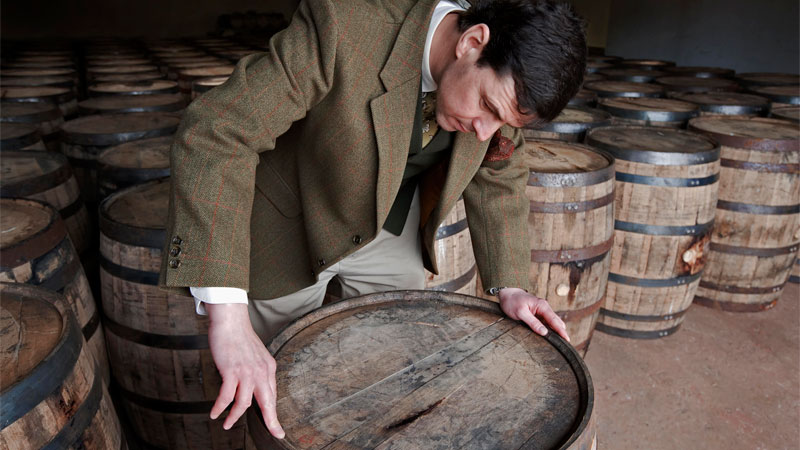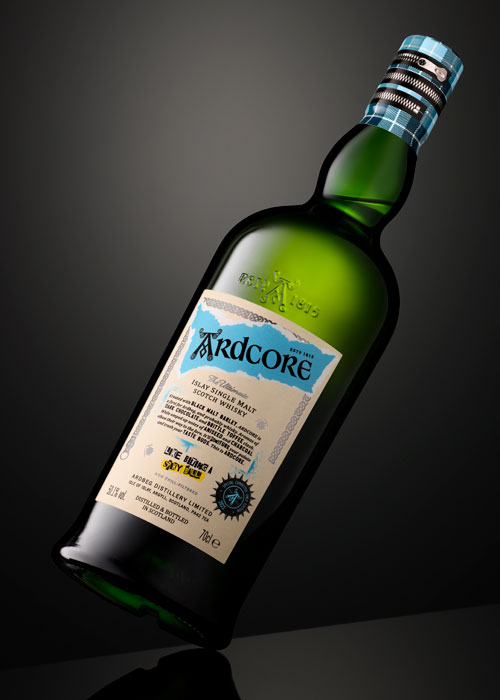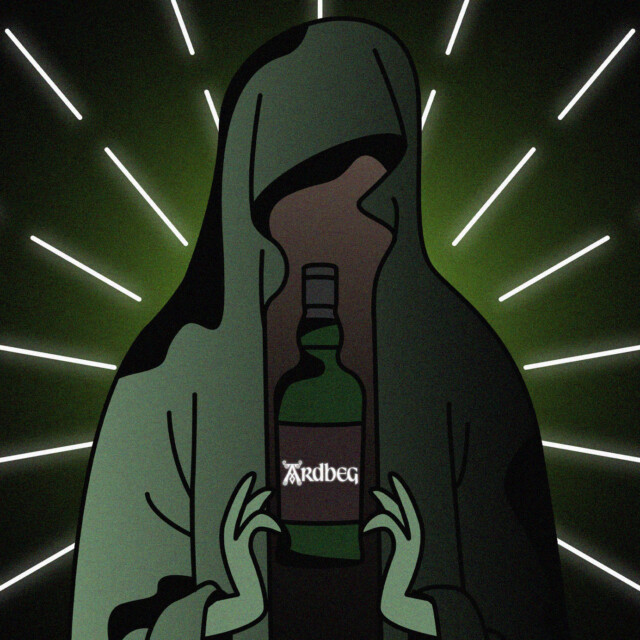The first time Dr. Bill Lumsden walked into Ardbeg Distillery, he noticed a shoebox on the wall of the mash house. “There’s a brand of safety shoes with steel toe caps called Totectors,” he recalls. “They always came in a very distinctive gray box with a crimson pattern on it.” Thinking the box must have some kind of meaning, Lumsden asked a worker about it. “He pulled it down and it was an electrical junction box. Covered with a shoe box.”
It was 1997, the Glenmorangie Company had just bought Ardbeg, and Lumsden — then distillery manager at Glenmorangie Distillery — was there to help restart the Islay distillery under a new regime. But “it was in terrible condition,” he says, “held together with Sellotape and string and chewing gum.” He was, he admits, nearly reduced to tears.
Although it’s unthinkable now, when a single cask just sold for a record-setting $19 million, Ardbeg was once on the brink of extinction. It had been mostly non-operational from the early 1980s, going years without firing up its stills or filling a barrel. Like many distilleries, Ardbeg had suffered the effects of over-production and declining demand, a phenomenon dubbed the “Whisky Loch” that reverberated industry-wide and led to dozens of permanent closures.

Ardbeg was nearly among them, but somehow scraped along, occasionally providing parts to its then-sister distillery Laphroaig. At the time Lumsden first visited, Ardbeg single malt was difficult to find; the whisky had primarily been used as a blending component, and only independent bottlers offered an occasional single malt. In fact, the first Ardbeg Lumsden ever tasted, shortly before his first visit to the distillery, was a 1978 Gordon & MacPhail bottling. “It completely blew my socks off, because I wasn’t that experienced in peaty whisky,” Lumsden says, noting that although he’d had other Islay whiskies, like Lagavulin and Caol Ila, he “didn’t understand that [heavily peated whisky] could also be really quite complex and quite interesting in that way.”
Dedicated Fanbase
Despite its scarcity — and likely at least in part because of it — Ardbeg was already a bit of a cult whisky, its virtues publicly extolled by whisky critic (and notorious sexist) Jim Murray. “He came up with a statement that it was unquestionably the greatest distillery on Earth, and if perfection on the palate exists, this is it,” Lumsden recalls. “So from that, it really tended to be very geeky, hardcore aficionados that knew about Ardbeg.”
Rebuilding the distillery’s stocks would take time. The early days of Ardbeg’s revival were overseen by industry veteran Ed Dodson, with Lumsden — who is currently the director of distilling, whisky creation, and whisky stocks for both Ardbeg and Glenmorangie — coming over from the Highlands to assist. Repairs to the decrepit plant and replacements of broken-down equipment went on for years. While the first new spirit ran off the stills on June 20, 1997, it took another three or four years for the distillery to be operating regularly year-round — and it took until 2008 for Ardbeg to release the first consistently available whisky made under the new ownership, its flagship 10-year-old.
Along the way, though, Ardbeg offered one-off bottlings of older casks and young whisky — catnip to its small base of existing fans and, as word spread, enticements for newcomers. The effort received a boost in 2000 with the launch of the Ardbeg Committee, a fan club that nodded to Islay’s dozens of longstanding community committees. “When you become part of a committee, you take a stake in the success of whatever the committee is trying to achieve, and that’s exactly what we wanted with our Ardbeg fans — for them to feel like they had a stake in the future of the distillery,” remembers Hamish Torrie, then-marketing manager for Ardbeg. The mission was framed in existential terms, he adds: “Help us make sure the doors of the distillery never close again.”
In return for joining the Ardbeg Committee (for free), members received invitations to visit, opportunities to attend events, and the chance to buy limited-edition whiskies. “What we were doing was building a sense of allure and, to be frank, envy because not everybody could get a bottle,” Torrie says, noting that this strategy also helped feed excitement about what was to come. “The other thing we did was start to give a sense of anticipation for the future Ardbeg, i.e., the Ardbeg made by Glenmorangie [Company].”
The response from whisky drinkers was overwhelmingly positive, especially when the distillery opened to visitors and many began traveling there in journeys akin to “making a holy pilgrimage,” Lumsden says. Ardbeg Day, celebrated on the last day of the island’s annual spring festival, Fèis Ìle, has become a rite of passage for die-hard fans, with bottle sales, music, revelry, and a high density of Ardbeg-related tattoos. While many whiskies attract devoted followings, few rival that of Ardbeg, and the relationship between distillery and fanbase is, in Torrie’s words, “umbilical. … It’s an amazing brand because it generates love.”
Opportunism and Experimentation
All of that goodwill is rooted in the whisky, of course, and even with its strong reputation among the cognoscenti, Ardbeg still had to start almost from scratch when building up its portfolio in the late 1990s and early 2000s. In the stillhouse and blending lab, Lumsden worked hard to ensure that the first single malts made under the Glenmorangie Company maintained Ardbeg’s established character and reputation while also developing their own, new personality.

Early on, he distilled a whisky that came to be known as the Oogling (Young Uigeadail), released as a sort of proof of concept for Ardbeg lovers. “I said, ‘I just want you to see and judge that we are maintaining the style of Ardbeg that you all know and love,’” Lumsden explains. Adding to the body of evidence was the Peaty Path to Maturity, a consecutive series that included Ardbeg Very Young (6 years old), Still Young (8 years old), and Almost There (9 years old), culminating in the first 10-year-old release, Renaissance, in 2008.
Over the years, as he has cemented Ardbeg’s standing in the whisky world, Lumsden has enjoyed a wide open field for experimentation. “We’ve always reclaimed the Ardbeg distillery for at least one month every year to do trials,” he says. Many of his innovations have ended up as limited-edition Committee bottlings; one-offs for Ardbeg Day, like the recently released Ardcore, made with black malt; and potential fodder for new additions to the core range down the road. Like Wee Beastie, added in 2020; at 5 years old, it’s a direct descendant of Ardbeg Very Young.
Lumsden also has an uncanny knack for turning mistakes or problems into opportunities, like the time in 2007 when the distillery’s boiler died and active fermentations, exposed to wild yeast, continued for weeks longer than normal. The subsequent new-make spirit diverged significantly from Ardbeg’s usual profile, and was bottled earlier this year as Fermutation, exclusive to the Ardbeg Committee. “We’ve always turned things like that in our favor,” Lumsden says. One of Ardbeg’s malt suppliers recently lost its peat kiln to fire; no doubt there will be some sort of “Ardbeg from the ashes” release in a few years.
When it reopened in 1997, Ardbeg distilled 250,000 liters of spirit; over the years, it ramped up to 1.4 million, and now, thanks to a recent expansion that took the number of stills from two to four, it has an annual capacity of 2.8 million liters. That means greater availability of standard bottlings and more experimental whiskies down the road — plus reassurance that the distillery will never shut its doors again.
“In Gaelic, ‘ard’ means headland and ‘beg’ means small — so we’ve got a small brand with a very big ambition behind it,” Torrie says. “Ardbeg was always going to be a niche whisky, and despite expanding our production over the years, it still will be a niche, cult whisky. That’s just the way it is.”
This story is a part of VP Pro, our free platform and newsletter for drinks industry professionals, covering wine, beer, liquor, and beyond. Sign up for VP Pro now!
